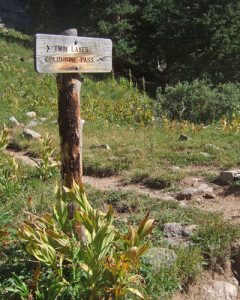Climbing Chicago Basin 14ers
Nearly 75% of the visitors to Chicago Basin plan to climb the nearby “Fourteeners”: Mount Eolus (14,083′), Windom Peak (14,082′), and Sunlight Peak (14,059′). This section provides information to help you plan a safe climb. General access, camping, and backpacking information is provided under Chicago Basin Trip Planning, so it will not be repeated here.
Maps and Guidebooks
When you approach the 14ers, the peaks you want to climb are not readily apparent. Mountaineering guidebooks outline the climbing routes on the peaks and their level of difficulty. It is strongly recommended that you choose routes that match your ability level, plan carefully, and stay on-route during your climb. Most climbing accidents occur when climbers get off-route, especially in severe weather.
For climbing Chicago Basin 14ers, the following maps are recommended:
- Mount Eolus, North Eolus, Sunlight Peak and Windom Peak – Colorado 14ers Series Topographic Hiking Map #16
- Mt. Eolus and Windom Peak: USGS 7.5 minute topographic maps, Columbine Pass quad
- Sunlight Peak: USGS 7.5 minute topographic maps, Storm King Peak
Maps and guidebooks for the Chicago Basin area are available by phone or mail from the our online bookstore. In Durango, stop by the SJMA Bookstore, which is open weekdays 8 to 4:30, located at 15 Burnett Court.
How Difficult Are They?
All 3 of the 14ers will get your heart pounding—in other words they are NOT easy. Climbing these peaks safely requires careful planning, good judgment, and extreme caution. It is strongly recommended that you consult mountaineering guidebooks before attempting these peaks so you are knowledgeable of the climbing routes and risks.
- The USDA Forest Service does not maintain trails up the peaks or recommend climbing routes.
- There is 3000′ of elevation gain from Chicago Basin to the top of the 14-ers.
- A great resource for the most recent trip reports can be found at 14ers.com.
Weather Hazards
Expect weather conditions on the fourteeners to be much cooler and more changeable than your weather at home.
- Before you leave home, check the long-term weather forecast for Silverton, Colorado—the town closest to Chicago Basin. Temperature drops about 3.5 degrees for each 1000′ increase in elevation, so expect the temperatures on top of the fourteeners to be about 17 degrees cooler than Silverton, even more if you take the chill factor from wind into account.
- Extreme weather includes wind, lightning, hail, or snow. Loose and slippery rocks make for uncertain footing. To avoid weather problems and summit safely, climbers typically leave camp at daybreak or before. Conventional wisdom is to be off the summit by noon, but if you look at the lightning statistics for Colorado, it would make sense to be off the summit before 11 AM if storms are building.
Base Camp Location
The important thing you should know is that camping is not allowed in Twin Lakes Basin. This includes the entire area bounded by the three 14ers. Twin Lakes may appear to be the perfect base camp location for climbing the peaks, but its alpine environment simply cannot withstand the impacts of thousands of climbers camping there. Soils are very erosive, and vegetation at this elevation has a short growing season (about 60 days a year) and does not have time to recover.
Approach Trails to the 14ers
The approach trails have been improved by the Colorado Fourteeners Initiative in cooperation with the US Forest Service. They are not shown on many maps, and are not clearly signed, but they are good trails. As the main trail nears the head of Chicago Basin, take a smaller trail that angles left (north) and climbs toward Twin Lakes Basin. The trail reaches the top of some cascading waterfalls, flattens out, and then climbs steeply to Twin Lakes. From where you first view the lakes, the approach trail to Mount Eolus is seen to the west (left). Continue hiking half way along the lower lake to find the approach trail to Sunlight and Windom Peaks climb to the east (right). There are multiple routes to the summits of these peaks, some of which may get you into trouble. Be prepared with a good map and route finding skills to reach the summits safely.

This is the only signage to get to the 14-ers. As the main trail nears the head of Chicago Basin, take a smaller trail that angles left (north) and climbs to Twin Lakes Basin.
Time Required
It generally requires 3 to 4 days to make the trip to Chicago Basin and climb the three 14ers. Consult guidebooks and maps for logistics, distances, and elevation gains.
